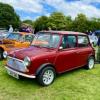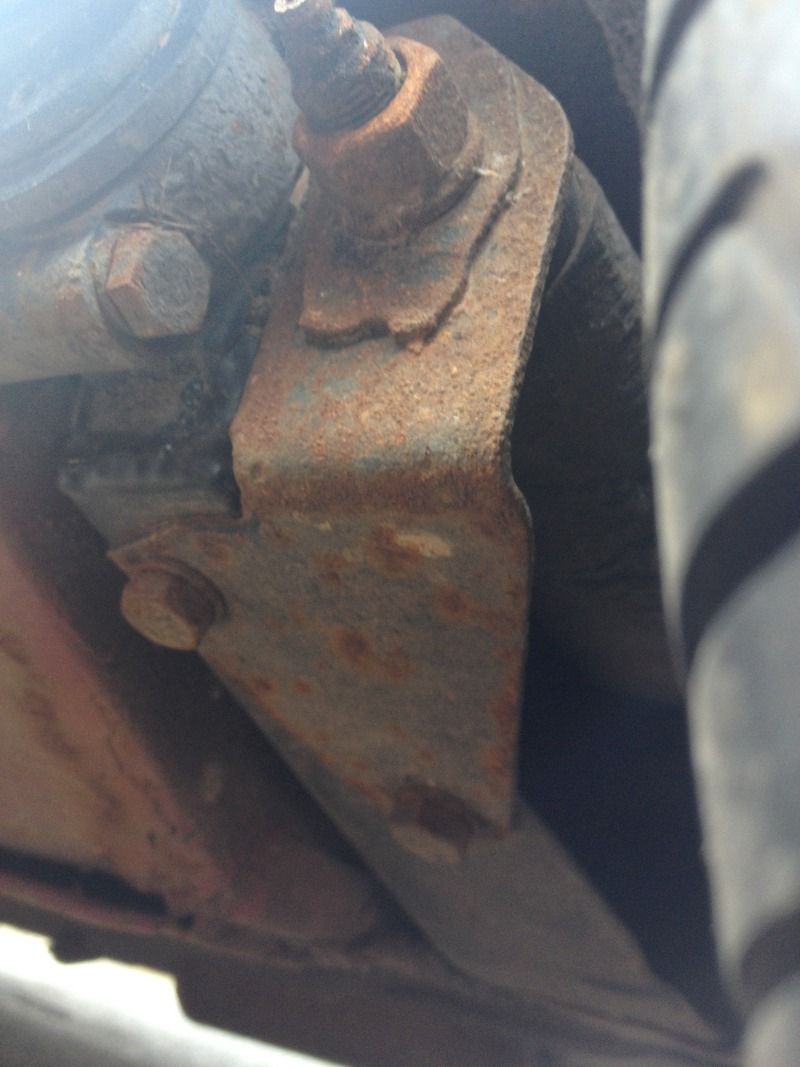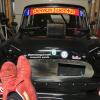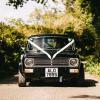
Suspension/steering Geometry
#1

Posted 08 May 2016 - 10:08 PM
This got me looking at the geometry and what has been fitted by the previous owner.
So far , I can see there are some adjustable Spax shocks up front, new shocks on the rear(unsure if they're adjustable), standard suspension arms & tie rods. On the rear are brackets on the radius arms but can't tell if they're adjustable.
Looking head on at the car, it seems there is a slight mismatch of camber/wheel offeset(?) from left side & right side.
Looking from the rear, the wheels seem like they have a little positive camber. But this maybe just me. Could be just no camber at all.
How can I tell if the brackets on the rear are adjustable?
Also what do people recommend for a good fast road set up?
#2

Posted 08 May 2016 - 10:14 PM
Yes minis have positive camber.
Adjustable things are quite noticeable.
Yes things can look not the same as the sides of a mini are not straight.
So.
What are your suspension settings.
Has it been lowered?
What wheels? And tyres?
#3

Posted 08 May 2016 - 10:19 PM
The suspension settings are quite critical on the classic Mini, especially the rear settings.
Whether or not your rear brackets are adjustable will be easy to see. If they have adjustment there will be small fittings for screw adjustment. if the brackets are plain faced, then they are not adjustable, but can be set more correctly.
The ideal settings for a 'not quite so slow road Mini' are generally as follows:
Front; 0.5 to 1.5 degree negative camber, which can be achieved with either different lower arms or offset lower arm inner bushes.
3 to 3.5 degrees caster which can be achieved with adjustable tie-bars.
1mm to 2 mm toe-out
Rear: zero to 0,5 degrees negative camber
1 mm to 2 mm toe-in
This can be achieved either with adjustable brackets or by filing the hole in the bracket forwards and/or upwards until the correct settings are achieved, then welding on a large washer to maintain the settings. If there is too much toe-in on the rear the brackets need to be shimmed away from the sub-frame mating face.
Accurate measurements are critical. When done both road-holding and handling will be much improved.
Set the car to standard ride height, not lowered for best overall performance on the normal roads.
Note that these settings do not necessarily apply with the 13" wheels/175 section width tyres when the camber for the front should be no more than 1 degree neg maximum and 0.25 degrees neg on the rear camber.
Edited by Cooperman, 08 May 2016 - 10:21 PM.
#4

Posted 09 May 2016 - 07:05 AM
Sorry you have said nothing in the words you have used.
Yes minis have positive camber.
Adjustable things are quite noticeable.
Yes things can look not the same as the sides of a mini are not straight.
So.
What are your suspension settings.
Has it been lowered?
What wheels? And tyres?
The problem is I don't know what's been used as I've just bought the Mini.
Like I've said, the front shocks are Spax (red if that makes a difference) adjustable. I've set them so they are 5 clicks in from the softest setting.
Rear shocks look new, but haven't checked if adjustable.
It doesn't look lowered. The trumpets look like the original items.
Wheels and tyres are 5" x 12" Minators with 165/60 R12 Yoko A539s.
#5

Posted 09 May 2016 - 07:31 AM
The suspension settings are quite critical on the classic Mini, especially the rear settings.
Whether or not your rear brackets are adjustable will be easy to see. If they have adjustment there will be small fittings for screw adjustment. if the brackets are plain faced, then they are not adjustable, but can be set more correctly.
The ideal settings for a 'not quite so slow road Mini' are generally as follows:
Front; 0.5 to 1.5 degree negative camber, which can be achieved with either different lower arms or offset lower arm inner bushes.
3 to 3.5 degrees caster which can be achieved with adjustable tie-bars.
1mm to 2 mm toe-out
Rear: zero to 0,5 degrees negative camber
1 mm to 2 mm toe-in
This can be achieved either with adjustable brackets or by filing the hole in the bracket forwards and/or upwards until the correct settings are achieved, then welding on a large washer to maintain the settings. If there is too much toe-in on the rear the brackets need to be shimmed away from the sub-frame mating face.
Accurate measurements are critical. When done both road-holding and handling will be much improved.
Set the car to standard ride height, not lowered for best overall performance on the normal roads.
Note that these settings do not necessarily apply with the 13" wheels/175 section width tyres when the camber for the front should be no more than 1 degree neg maximum and 0.25 degrees neg on the rear camber.
Thanks, that's a great help.
I'll see if I can get a photo posted of the rear brackets.
I've been looking at the Negative Camber packages that are available. Are there any advantages to rose jointed tie rods?
#6

Posted 09 May 2016 - 10:38 AM
For a road car you don't need anything too special, just the settings posted above.
It will then have good road-holding and predictable handling.
#7

Posted 09 May 2016 - 10:58 AM
Rose jointed arms are excellent for racing but not for road or even for rally use.
For a road car you don't need anything too special, just the settings posted above.
It will then have good road-holding and predictable handling.
Thanks.
I remember a friend having a TR8 with rose jointed tie rods & it handled like a dream. He did however only use it for road rallying.
#8

Posted 09 May 2016 - 11:55 AM
I don't believe the brackets fitted are adjustable.

#9

Posted 09 May 2016 - 04:49 PM
Yes, this looks standard.
If you are setting up rear wheels with less positive camber one way is to 'slot' the large hole for the radius arm. But you really need to measure it all up accurately first to be sure about how much to remove.
#10

Posted 11 May 2016 - 08:26 PM
Can I just clarify a few bits with this. Firstly, I'm sure they are correct as you've written them cooperman, but this could be mis-read, as I have done setting tracking this evening. The tracking measurement is in mm, as opposed to degrees, now to save someone else doing what I did and setting the wheels to 1.5 degrees toe out and thinking it looks wrong. Degrees and mm are very different, though the Dunlop gauges I used only had degrees readout. I found this conversion table online and works 1.5mm to be '46 for 12" wheels. I trust this is near to correct. To save any confusion, do you happen to know the reading in degrees cooperman?
The ideal settings for a 'not quite so slow road Mini' are generally as follows:
Front; 0.5 to 1.5 degree negative camber, which can be achieved with either different lower arms or offset lower arm inner bushes.
3 to 3.5 degrees caster which can be achieved with adjustable tie-bars.
1mm to 2 mm toe-out
Rear: zero to 0,5 degrees negative camber
1 mm to 2 mm toe-in
http://www.trackace....rsion chart.pdf
I'm also planning to do some grass auto tests and rally sprints in mine, would this setup also suit that sort of event?
Regards, H
Edited by Goacher65, 11 May 2016 - 08:27 PM.
#11

Posted 11 May 2016 - 08:47 PM
For grass auto-tests the important thing is tyre grip and braking on grass. The suspension settings play little part as the speeds are low (relatively) and it is a matter of good car control. Make sure the handbrake is working!
For historic rallying the settings I have given work well, but the most important things are strength and reliability, followed by road-holding & handling.
The settings I have given will work well for rallying and also set the suspension to standard ride height or raise, maybe a cm or two. Dampers must not be set too hard as good compliant damping is needed rather than rock-hard settings.
For gravel rallying the brake, fuel and battery lines must be run inside the car and under-shielding is important. So fit a sump guard (and an oil cooler).
Use Valvoline VR1 20w50 oil.
You will need better brakes and carbon-metallic pads are the very best. Definitely not 'Green Stuff' or similar. For brake fluid use a high-temperature comp. fluid.
There are lots of other things a historic rally car needs, but it's too much to list here.
Don't forget the FIA roll cage, seats and full harness belts.
#12

Posted 24 May 2016 - 02:42 PM
What exactly is the standard ride height for a mini?
#14

Posted 26 July 2016 - 10:31 AM
#15

Posted 26 July 2016 - 06:35 PM
With 1mm of toe-in or toe-out you won't see any additional tyre wear.
1mm of toe-in or toe-out is less than for a standard car
1 user(s) are reading this topic
0 members, 1 guests, 0 anonymous users

















